Ireland from Union to Partition
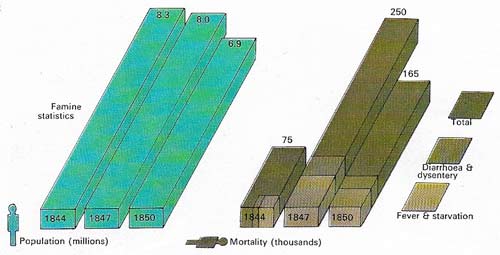
Figure 1. The Great Famine of 1845-1849 was a disaster on an unprecedented scale in Irish history. The total figures for deaths and disease disguise the famine's uneven impact, most severe in the West and less damaging in the North East. In 1845-1846 government action relieved starvation, but renewed crop failure overwhelmed the shadowy administrative structure. The ensuing horror generated intense hatred against Britain.
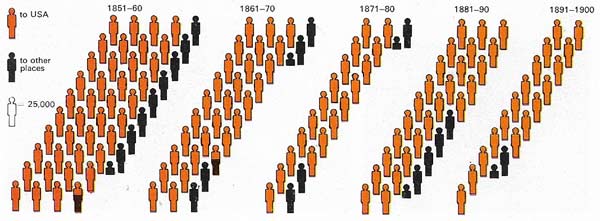
Figure 2. Inhibitions against emigration were broken by the Famine and a steady flow of emigrants began to leave Ireland. By 1911, when the population stabilised at nearly four-and-a-half million, more Irish lived on North America, Britain and the Empire than in Ireland. Their departure made possible a better standard of living in Ireland and added an international dimension to Irish nationalism.
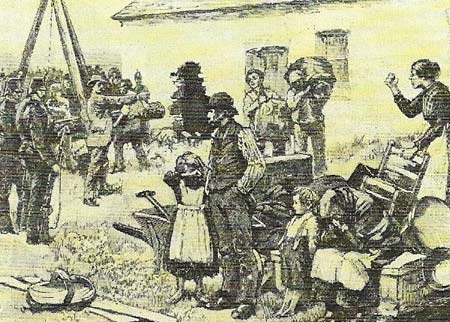
Figure 3. Eviction of tenants was common in the 1870s and 1880s when conflicts between tenant farmers and landlords were at their sharpest. Landlords did not consolidate sufficiently, being effectively restrained by popular opposition, but with tenants of tiny holdings unable to live, let alone pay rent, amalgamation into viable farms was the only economic solution. The Land League seized on evictions to focus mass resentment against the landlord system.
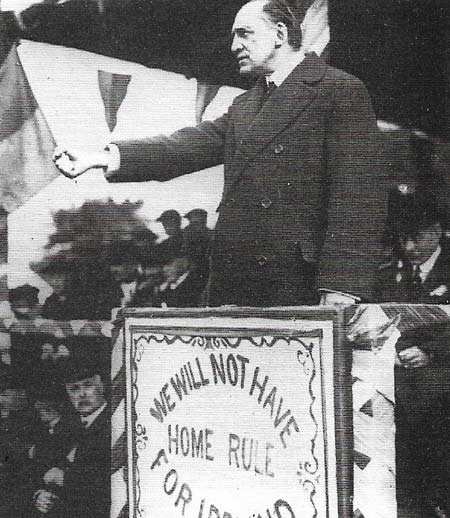
Figure 4. Edward Carson (1854–1935) led the Ulster Unionists from 1910–1920, pledging and arming them to resist Home Rule in any form. In 1914 his offer to accept Home Rule with the exclusion of Ulster was rejected. In 1916 he reduced this demand to only the six most Protestant Ulster counties. Although Carson preferred continued integration with the United Kingdom, he accepted the creation of a separate parliament for the six counties in Belfast in 1920.
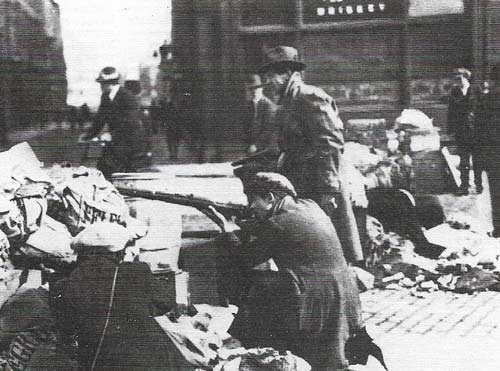
Figure 5. The Easter Rising of 24–29 April 1916, led by the Irish Volunteers and the Irish Citizen Army, seized several public buildings in the centre of Dublin before surrendering to the British army. Although many Irish people were out of sympathy with the insurrection itself support for the republican cause grew after the secret execution of the seven signatories of Proclamation of the Irish Republic and eight other rebel leaders, and widespread arrests.
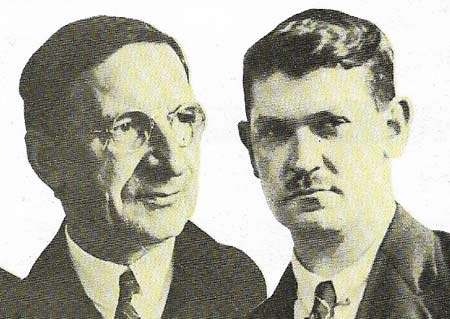
Figure 6. Michael Collins (1890–1922) (right) was a leader of the Irish struggle for independence. After 1916 he became involved in Sinn Fein politics and was elected to the Dail in 1919, becoming a leading member of the provisional government. Eamon de Valera (left) was the senior surviving officer of the 1916 rising and political Irish leader. He became president of Sinn Fein in 1917, and President of the Republic and of Dáil Éireann (Irish lower house) in 1919.
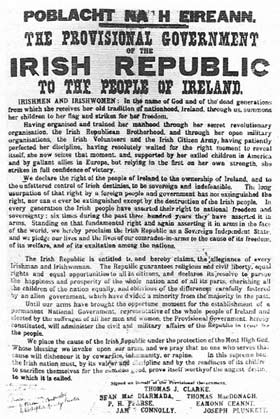
Figure 7. On Easter Monday 24 April 1916, Irish republicans, socialists, and other separatists rose in armed revolt against British rule in Ireland. The rebellion was quickly crushed, the last rebel strongholds surrendering to British troops six days after the republic had been proclaimed (the proclamation is shown here). In fighting, 100 British troops and 450 Irish were killed. The rebel leaders were executed, notably Patrick Pearse (1879–1916) and James Connolly (1870–1916). Only Eamon de Valera (1882–1975) survived because he had been born in the USA. However these measures, in the aftermath of the rebellion, won Irish opinion to the republican cause.
The legislatures of Dublin and London were combined on 1 January 1801 for reasons of state – British reasons, although the Union also suited those Protestants of the Irish Ascendancy who feared the rising forces of Catholicism and democracy. Other Irish Protestants opposed the measure, distrusting Westminster's will to preserve Protestant privileges, while Catholic leaders tended to favor Union, accompanied as it was to be by legislation to grant Catholics the right to sit in the Union Parliament.
Consequences of the Union
In the event, Protestant fears of the Union turned out to be as unfounded as Catholic hopes. Protestants continued to represent Irish constituencies in Parliament, the Anglican Church remained established and the separate Irish administration continued to favor Protestant interests. To Catholics, the Union provided scant blessing. Their right to sit in Parliament was not conceded, the prime minister, the younger William Pitt (1759–1806) preferring to resign rather than jeopardize the war effort against France by provoking a constitutional crisis over King George III's (reigned 1760–1820) opposition to Catholic emancipation. Emancipation became, therefore, a principal issue of the Union Parliament: its denial completely disenchanted Catholics with the Union.
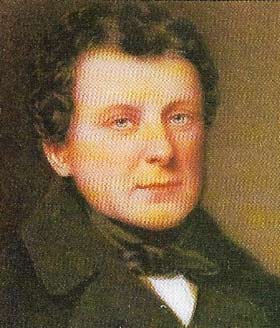 |
| Daniel O'Connell, (1775–1847), the first politician in the British Isles to mobilise mass support behind his cause, won Catholic emancipation in 1829. As MP for Clare, he alternately bargained for reforms and attack the Union itself. But support for his Repeal Association declined after 1843 when he refused to risk bloodshed in opposition to Westminster and the Union. |
The land problem and Home Rule
The Great Famine of 1845–1849 (Figure 1) stressed the enduring problem of 19th-century Ireland – the imbalance of its land and people. The Irish population had grown alarmingly from five-and-a-half million in 1800 to more than eight million by 1845. Crowded together in smallholdings subdivided into uneconomic units, increasingly dependent upon a potato diet, the Catholic laborers and tenant farmers presented a desperate spectacle. Without industrial alternatives, the peasantry had to remain on the land, exposed to periodic crop failures.
At Westminster, tenant and Catholic spokesmen tried to coordinate Irish MPs to deal with Irish issues, but, in practice, allegiance to the Liberal and Tory parties prevailed. But after the false start of Isaac Butt's (1813–1879) Home Rule League (1873), Charles Stewart Parnell (1846–1891) welded together a disciplined Irish Party in pursuit of Home Rule.
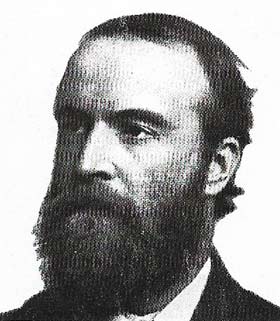 |
| Charles Stewart Parnell, MP for Meath from 1875, led 59 Irish MPs at Westminster by 1880, soon molding them into a disciplined salaried party (86 strong at its height) pledged to support Home Rule. Backed by Constituency branches, mass Land League support and secret Fenian cooperation, he made Home rule credible, and in 1886 won the Liberal Party over to his cause. Parnell lost Catholic support after he was cited in a divorce case in 1890. |
As a result of the long-felt grievance over ownership, unsatisfactory tenancy arrangements, misguided legislation, a further series of bad harvests from 1877, and the organization of the Irish National Land League, rural discontent was brought to a new focus between 1879–1882 (Figure 3). Parnell yoked this to his parliamentary demands, while the shadowy Irish Republican Brotherhood (the Fenian movement) begun by James Stephens (1825–1901) in 1858 and now given direction by John Devoy (1842–1928) from America, lent clandestine support. Coercion proved an insufficient government response but the Liberal leader, William Gladstone (1809–1898), accepting the logic of Parnell's position, attempted in vain to devolve a Home Rule parliament to Dublin.
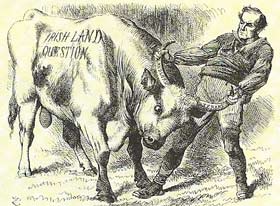 |
| William Gladstone, seen in the cartoon struggling with the Irish question, became absorbed with Irish affairs after 1886 and his unsuccessful first Home Rule Bill. Prior to that, in 1869, he had disestablished the Irish Church and passed Land Acts, in 1870 in 1881, which gave tenants greater security and legally fixed rents. In 1893 he introduced the second Home Rule Bill, which was rejected by the House of Lords. |
Meanwhile, the Home Rule Party, split in 1890 and discredited by internal feuds, was being outflanked by other movements working to "de-Anglicize" Ireland and to win complete independence. In 1906 Arthur Griffith (1872–1922) succeeded in mobilizing disparate political groupings into his own movement, Sinn Fein, dedicated to economic self-sufficiency and political withdrawal from the Union. Yet, even while Sinn Fein gathered strength, the Home Rule Party, shamed into unity in 1900 under the leadership of John Redmond (1856–1918), received renewed authority from political circumstances in Britain. The return of the Liberals there in 1906 made Home Rule again a possibility.
Ireland divided
From 1912 onwards, tension grew first with the Protestant Unionists arming (Figure 4), then Home Rulers – the one to prevent, the other to enforce a bill expected to become law in 1914. Only the outbreak of World War I subsumed this minor quarrel within a mightier conflict. The operation of Home Rule was postponed until the end of the war.
Before that, however, republicans, socialists and other separatists had risen in 1916 (Figure 6) to proclaim an independent Irish Republic. They were quickly crushed and their leaders executed, but these groups reformed in 1917 to merge under the Sinn Fein banner.
The Home Rule Party, compromised by its attachment to the British war effort and the indecisive leadership of the dying Redmond, could not be saved from humiliation in the post-war elections. But Sinn Fein, while winning 73 seats to the Party's 6, could not prevent the Unionists from winning 26 in the North East.
Prime minister Lloyd George (1863–1945) belatedly turned again to Ireland in 1919. In 1920 he created two Home Rule parliaments: one in Dublin for 26 of Ireland's 32 counties; the other in Belfast for the remainder in the North East. Reluctantly, Northern Unionists accepted this compromise, although they had been committed to preserving the 9-county Province of Ulster from Dublin rule. Contemptuously, Southern Nationalists, by now swam to win a 32-county Irish Republic, refused either to accept the limited powers offered or the partition of the island involved.
 ,are,,,
,are,,,